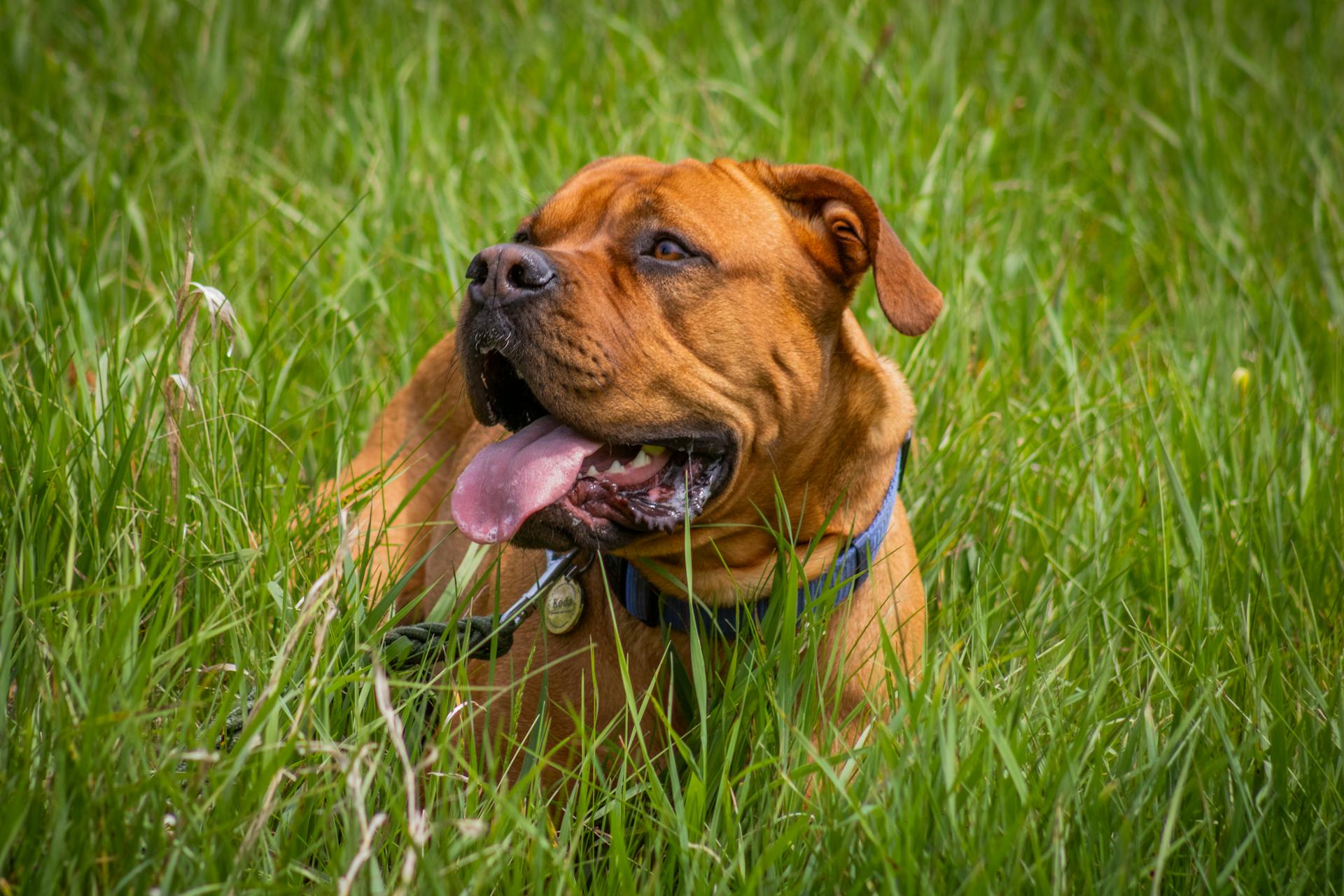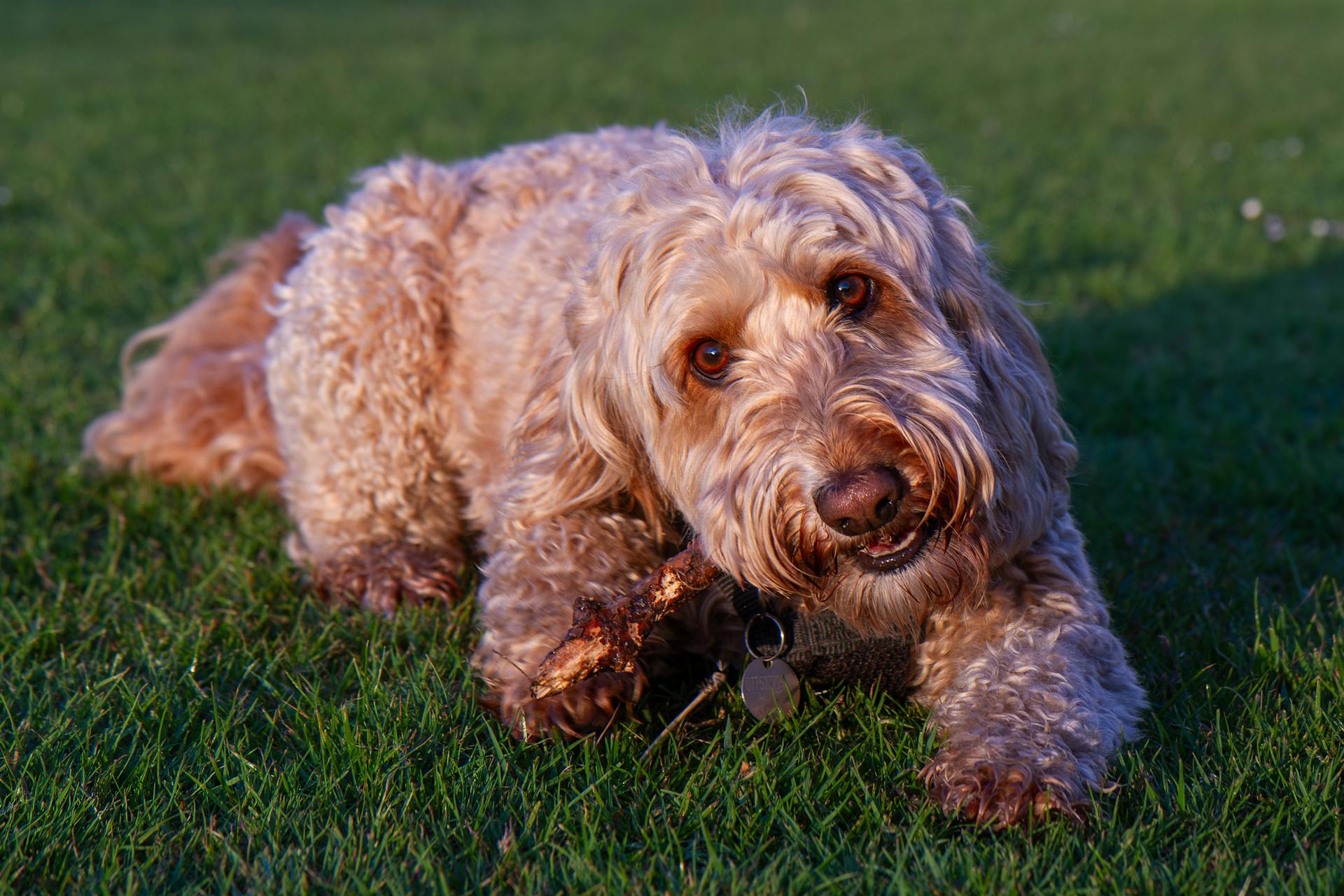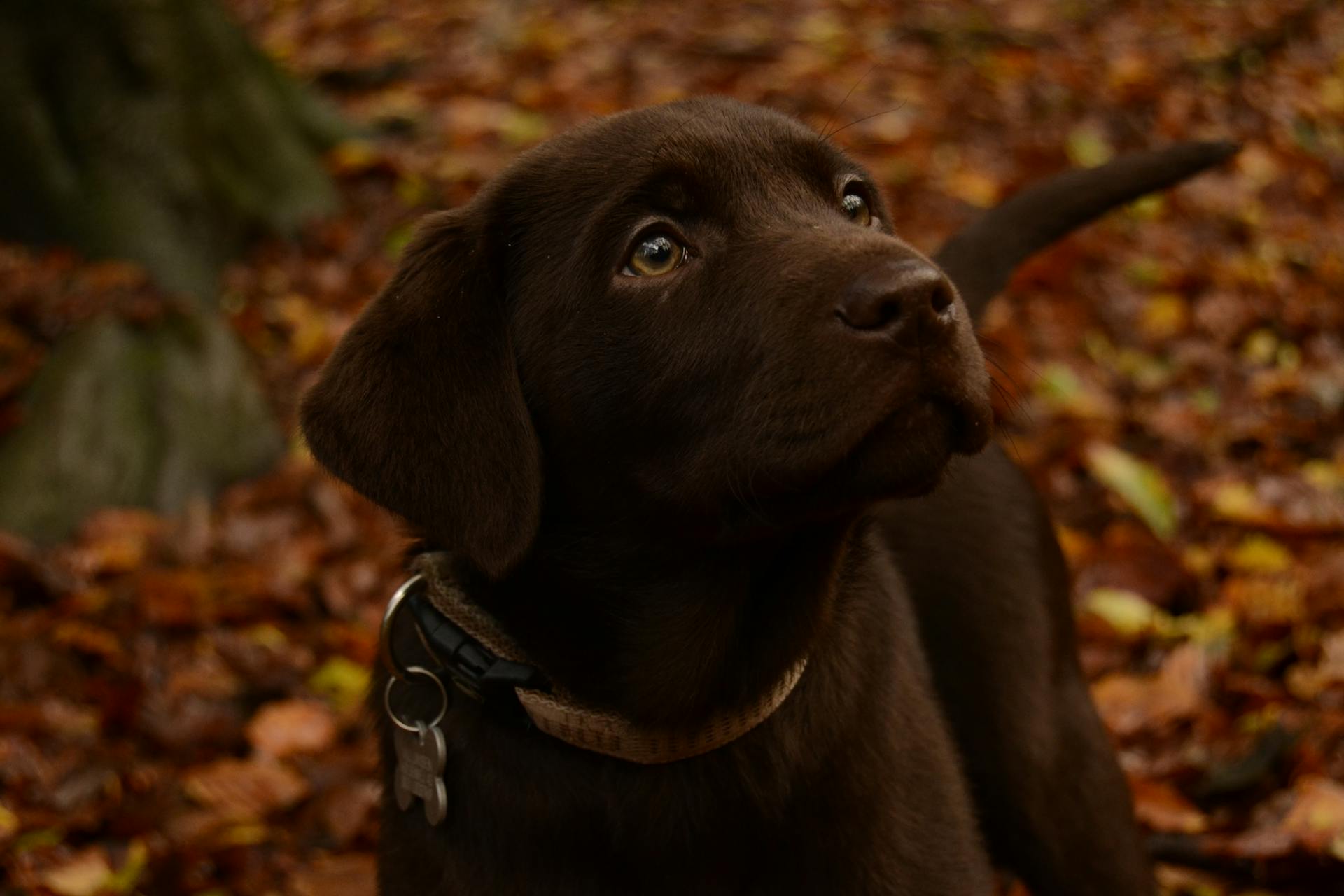
The Brown Neapolitan Mastiff is a majestic breed that commands attention and respect. They are a rare variation of the Neapolitan Mastiff, with a distinctive brown coat.
Originating from Italy, this breed has a long history dating back to the 2nd century BC, where they were used as guard dogs and protectors of the Roman Empire.
Brown Neapolitan Mastiffs are known for their massive size, with males weighing up to 230 pounds and standing at 26 inches tall.
Temperament and Care
Brown Neapolitan Mastiffs are known for their gentle nature, making them a great addition to families with children. They're often referred to as "gentle giants" due to their large size and calm demeanor.
Despite their size, Brown Neapolitan Mastiffs are not high-maintenance when it comes to exercise. In fact, they're often described as "couch potatoes" who would rather lounge around with their family than engage in strenuous activity.
Early socialization is crucial for Brown Neapolitan Mastiffs, as they can be wary of newcomers. However, with proper training and socialization, they can learn to distinguish between friends and foes.
Temperament
The Neapolitan Mastiff's temperament is a unique blend of loyalty, gentleness, and protectiveness. They are wary of newcomers but rarely reactive, making them a great watchdog.
These gentle giants are not clingy or highly strung, but they do require attention and interaction with their family. They love to lounge near their people and may even snuggle up on their lap.
Neapolitan Mastiffs are not naturally social with other dogs, so proper introductions and socialization are key. They may not get along with other dogs, especially those of the same sex, and may even chase cats.
Early socialization is crucial for teaching them to distinguish between friends and foes. They can be willful and independent if not properly trained and socialized.
Neapolitan Mastiffs are highly protective of their family and will stand in the way, fight without hesitation, and refuse to back down if they sense any threat. They need an experienced, devoted, and firm owner who can provide positive training and guidance.
They can be lazy when fully grown, so regular daily walks are necessary to prevent obesity. A Mastino's family must be in control at all times, requiring ongoing obedience training and firm handling.
See what others are reading: Why Is a Tibetan Mastiff so Expensive
Training
Training a Neapolitan Mastiff requires patience, consistency, and positivity. They learn best with rewards, praise, and fun playtimes when they do a good job.
Neapolitan Mastiffs are intelligent dogs, but they can be strong-willed and independent, especially during their adolescent years. This is why it's essential to start training early and establish your leadership before they grow to over 100 pounds.
They have a natural desire to please, so repetition is key. Focus on a few behaviors at a time, aiming for simplicity and perfection. For example, teaching a really long sit that outlasts distractions with ease is more effective than teaching "stay".
Socialization is crucial for these pups, as they can be wary of strangers. Start socializing your dog while they're a puppy by taking them on walks and letting them see other people and dogs. Enroll them in puppy school to learn how to play nicely with other puppies and meet people outside their family.
You might like: Breeds of Dogs That Start with H
Training sessions should be short and predictable, as Neapolitan Mastiffs can quickly tire of training. Keep sessions positive and avoid harsh punishment, setting your dog up for frequent successes to keep them engaged and eager to please.
Consistent rules and boundaries at home are vital, especially from a young age. Enforce strict rules and boundaries to prevent unwanted behaviors from turning into massive frustrations when they're adults.
Food Requirements
A Neapolitan Mastiff's diet is a top priority, and it's crucial to feed them high-quality large breed dog food that's formulated to slow their growth. This means avoiding foods that are high in calcium and fat, as they can lead to developmental orthopedic disease.
They need large or giant-breed dog food, and it's essential to choose a formula that's specifically designed for their needs. Many products include supplements like glucosamine, chondroitin, and omega-3 fatty acids to support and protect their joints.
As a giant breed, a Neapolitan Mastiff will eat about 6-8 cups of dry food daily. Feeding them several smaller portions throughout the day can help prevent bloat, a common issue for their breed.
You might enjoy: English Mastiff Large
Exercise
When it comes to exercising your Neapolitan Mastiff, a gentle approach is key. They don't need a lot of exercise, and you can avoid injury by keeping workouts short and sweet.
A 30-45 minute walk is a great place to start, as it allows your dog to get some fresh air and stretch their legs without overexerting themselves.
Environment
Neapolitan Mastiffs are a giant breed that thrive in medium-to-large-sized homes, making apartments workable if they're spacious and have an elevator.
Their quiet and adaptable nature makes them a great fit for families with children, but it's essential that both the dog and kids have been taught to interact safely and respectfully.
These pups can get along with cats if they're raised together from puppyhood, but they may need extra training and socialization if you're adding them to a home with other dogs.
Neos prefer colder climates and can quickly overheat in hot weather, so it's best to limit walks to the cooler parts of the day and keep them hydrated with fresh water.
Health and Wellness
The brown Neapolitan Mastiff is a lovable breed, but they do come with their share of health issues. With a life expectancy of 7 to 9 years, it's essential to be aware of the potential problems that can arise.
Cherry eye, a condition where the nictitans gland prolapses, is quite common in Neapolitan Mastiffs. This can cause discomfort and even lead to surgery.
Hip and elbow dysplasia are also prevalent in this breed. It's a hereditary condition that can cause pain, lameness, and arthritis, and treatments range from weight management to surgery.
Facial fold infections are another concern, as the skin folds can become a breeding ground for bacteria. Regular bathing and grooming can help prevent these infections.
Gastric dilatation volvulus, or bloat, is a life-threatening condition that requires immediate attention. Feeding smaller meals throughout the day and using a slow feeding bowl can help reduce the risk.
Dilated cardiomyopathy, an inherited heart condition, can lead to heart failure. Daily medication is often the course of treatment for this condition.
Intriguing read: Neapolitan Mastiff Lifespan
Here are some common health issues to watch out for in your brown Neapolitan Mastiff:
- Cherry eye
- Hip and elbow dysplasia
- Facial fold infections
- Gastric dilatation volvulus (bloat)
- Dilated cardiomyopathy
It's also essential to monitor your dog's skin and eye health, as skin allergies and eye disorders such as ectropion, entropion, and cherry eye can occur. Regular veterinary check-ups can help catch any potential issues early on.
Grooming
Brown Neapolitan Mastiffs require regular brushing to keep their shedding under control. Brush your pup with a slicker brush two or three times a week.
Their wrinkly nature means their folds need extra attention. Clean their folds, especially around the face, to prevent infection.
Drool, dirt, and food can accumulate in their folds, causing problems if not cleaned. Check their ears for debris, redness, and swelling, and contact your vet if you notice anything unusual.
A bath every four to six weeks will keep their coat shiny and smelling fresh. Bathtime is a good time to trim their nails, as the bath softens them, making them easier to clip.
You'll know they're ready for a nail trim when you can hear them clacking on hard surfaces. Brush their teeth daily to prevent health problems like gum disease.
An annual professional teeth cleaning by your vet is mandatory.
Expand your knowledge: Dogo Argentino Teeth
Owning a Brown Neapolitan Mastiff
They're low-energy and relatively low-maintenance dogs, but that doesn't mean they're easy to own.
Neapolitan Mastiffs are trainable and astute, but they're also independent, so they might ignore a command if it doesn't suit them.
They're indoor dogs and want to stick by their owner's side, which can sometimes make them agitated if someone tries to muscle in on their territory.
Having assorted visitors over from a young age can help them adapt to regular guests and dull their territorial sense.
Once mature, they'll have fewer issues when you have adults or your kids' friends over for the day, as they're naturally shrewd and good at determining who's trustworthy.
Frequently Asked Questions
Is a Neapolitan Mastiff a good family dog?
Yes, a Neapolitan Mastiff can make a great family dog due to their loving and gentle nature. However, they require careful supervision around small children due to their large size.
How much is a Neapolitan Mastiff worth?
The cost of a Neapolitan Mastiff can range from $1,500 to $4,000 or more, depending on factors such as breeder reputation and bloodline. If you're considering bringing one home, learn more about the breed's needs and costs to ensure it's the right fit for you.
Featured Images: pexels.com


